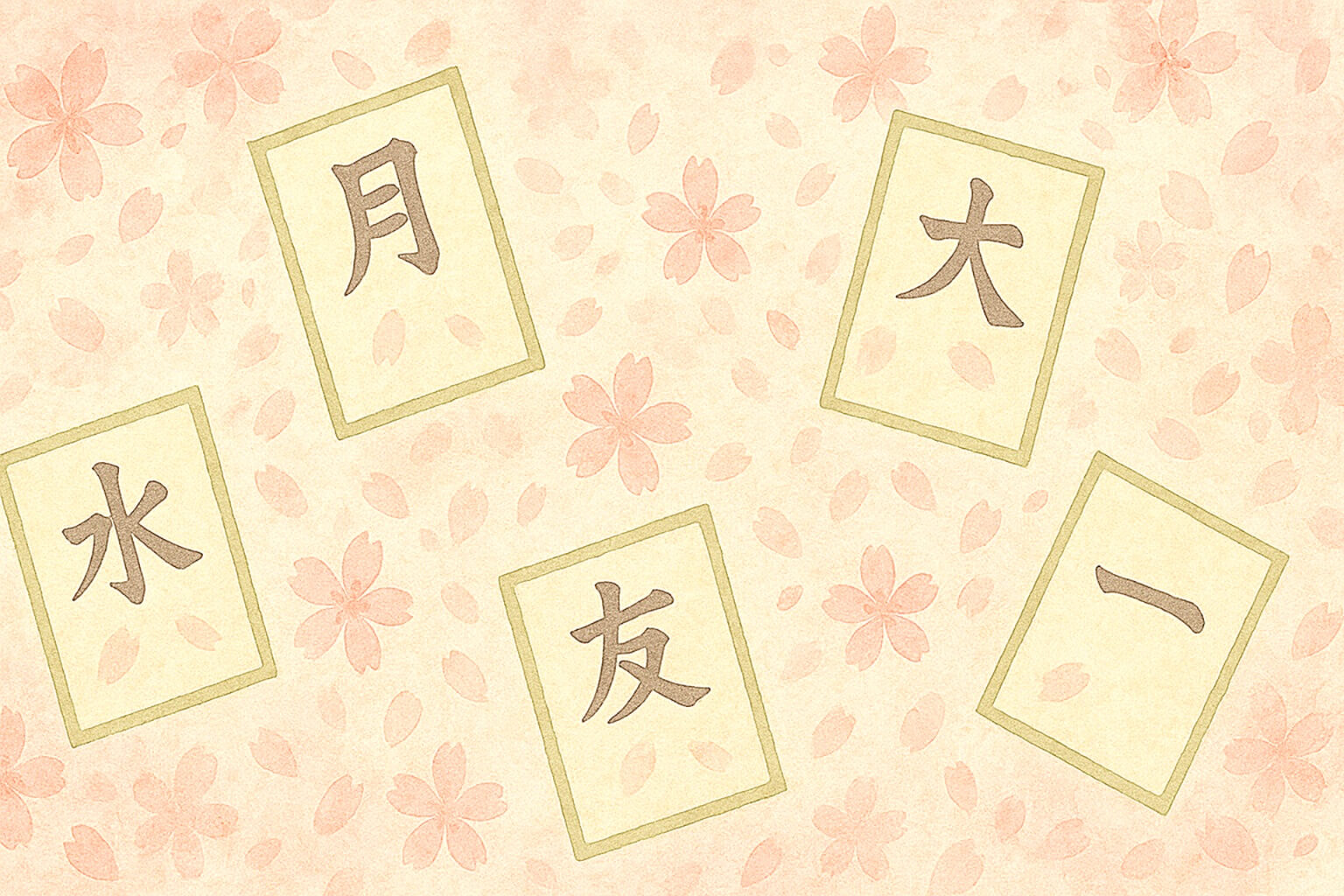
Learning Japanese kanji can feel like climbing a mountain blindfolded. With over 2,000 characters in common use, it’s easy to get overwhelmed. But here’s the good news: not all kanji are created equal. A relatively small group appears again and again in daily life. Learn those first, and you’ll unlock a huge portion of everyday Japanese.
This article introduces 50 of the most common kanji and gives you a smart, practical strategy for learning them—without drowning in flashcards or losing motivation.
Why Focus on the Most Common Kanji?
Although 50 kanji make up only about 2% of the total, they appear in 30–40% of everyday written Japanese—newspapers, signs, menus, and subtitles included. In other words, this is a high-leverage approach: learn less, gain more.
The 50 Most Common Kanji
Here’s a list of the top 50 kanji found in modern texts and newspapers. For each character, you’ll see its meaning and a common reading.
| Kanji | Meaning | Common Reading |
|---|---|---|
| 一 | One | いち (ichi) |
| 二 | Two | に (ni) |
| 三 | Three | さん (san) |
| 四 | Four | し / よん (shi/yon) |
| 五 | Five | ご (go) |
| 六 | Six | ろく (roku) |
| 七 | Seven | しち / なな (shichi/nana) |
| 八 | Eight | はち (hachi) |
| 九 | Nine | きゅう / く (kyuu/ku) |
| 十 | Ten | じゅう (juu) |
| 人 | Person | ひと / にん / じん (hito/nin/jin) |
| 日 | Day/Sun | にち / ひ (nichi/hi) |
| 月 | Month/Moon | げつ / がつ / つき (getsu/gatsu/tsuki) |
| 火 | Fire | か (ka) |
| 水 | Water | すい (sui) |
| 木 | Tree/Wood | もく (moku) |
| 金 | Gold/Money | きん (kin) |
| 土 | Earth | ど (do) |
| 本 | Book/Base | ほん (hon) |
| 中 | Middle | ちゅう / なか (chuu/naka) |
| 大 | Big | だい / おお (dai/oo) |
| 小 | Small | しょう / ちい (shou/chii) |
| 上 | Up | じょう / うえ (jou/ue) |
| 下 | Down | か / した (ka/shita) |
| 左 | Left | さ (sa) |
| 右 | Right | う / みぎ (u/migi) |
| 出 | Exit/Leave | しゅつ / で (shutsu/de) |
| 入 | Enter | にゅう / い (nyuu/i) |
| 学 | Study | がく (gaku) |
| 校 | School | こう (kou) |
| 生 | Life/Student | せい / しょう (sei/shou) |
| 年 | Year | ねん (nen) |
| 時 | Time/Hour | じ (ji) |
| 見 | See | けん / み (ken/mi) |
| 行 | Go | こう / い (kou/i) |
| 来 | Come | らい / く (rai/ku) |
| 食 | Eat | しょく / た (shoku/ta) |
| 飲 | Drink | いん / の (in/no) |
| 話 | Speak | わ / はな (wa/hana) |
| 聞 | Hear | ぶん / き (bun/ki) |
| 読 | Read | どく / よ (doku/yo) |
| 書 | Write | しょ / か (sho/ka) |
| 買 | Buy | ばい / か (bai/ka) |
| 車 | Car | しゃ / くるま (sha/kuruma) |
| 電 | Electricity | でん (den) |
| 駅 | Station | えき (eki) |
| 先 | Before | せん / さき (sen/saki) |
| 今 | Now | こん / いま (kon/ima) |
| 名 | Name | めい / な (mei/na) |
| 友 | Friend | ゆう / とも (yuu/tomo) |
Common Kanji in Context
To make these characters more memorable, let’s look at five of them in real example sentences. Seeing kanji in action is one of the best ways to learn how they’re actually used.
人 (Person)
Reading: ひと / にん / じん
Meaning: Person, human
あの人は先生です。
Ano hito wa sensei desu. — That person is a teacher.
食 (Eat)
Reading: しょく / た
Meaning: To eat, food
朝ごはんを食べましたか?
Asagohan o tabemashita ka? — Did you eat breakfast?
行 (Go)
Reading: こう / い
Meaning: To go, travel
今日は学校に行きません。
Kyō wa gakkō ni ikimasen. — I’m not going to school today.
見 (See)
Reading: けん / み
Meaning: To see, look
映画を見たいです。
Eiga o mitai desu. — I want to watch a movie.
名 (Name)
Reading: めい / な
Meaning: Name, fame
あなたの名前は何ですか?
Anata no namae wa nan desu ka? — What is your name?
How to Learn These Kanji (Without Burning Out)
Here’s a simple, effective approach to learning these characters and making them stick:
-
Group by Theme
Study logical sets such as numbers, directions, school-related words, or verbs. Your brain remembers better when characters are connected. -
Use Spaced Repetition (SRS)
Tools like bunpo integrate spaced repetition and bite-sized reviews to help you retain kanji more effectively—without feeling overwhelmed. It’s like having a personal memory coach right in your pocket. -
Write Them — But With Purpose
Handwriting reinforces memory, especially for tricky characters. Don’t spend hours copying kanji mechanically; instead, write them in meaningful words or sentences. -
See Them in Context
Watch subtitled anime, read graded readers, or try NHK Easy News. When you encounter kanji in real-life contexts, they’ll stick much more easily. -
Use Mnemonics
Create vivid or funny stories to link the shape and meaning. For example: the kanji for “tree” (木) actually looks like a tree. Simple, but effective.
Final Thoughts
You don’t need to know every kanji to start reading Japanese—just the right ones. By mastering these 50 essential characters, you’ll gain significant reading power and build strong momentum.
Start small, stay consistent, and remember: kanji become easier the more you use them in real life, not just when you study them on a page.



